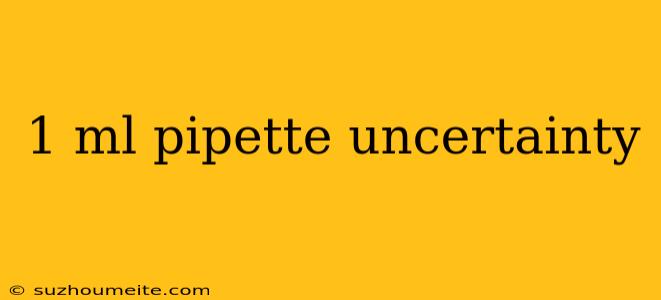1 mL Pipette Uncertainty: Understanding the Limits of Precision
Introduction
Pipettes are a crucial tool in laboratory settings, allowing scientists to accurately measure and transfer small volumes of liquids. However, even with the most precise instruments, there is always some degree of uncertainty associated with measurements. In this article, we will explore the concept of uncertainty in 1 mL pipettes and discuss its implications for laboratory results.
What is Uncertainty in Pipettes?
Uncertainty in pipettes refers to the range of values within which the true value of a measurement is likely to lie. In other words, it is a measure of the amount of error or variation that can be expected in a measurement. In the case of a 1 mL pipette, uncertainty can arise from various sources, including:
- Instrumental limitations: The mechanical limitations of the pipette itself, such as the accuracy of the plunger or the calibration of the instrument.
- Operator error: Human error, such as incorrect technique or misreading of the meniscus.
- Environmental factors: Temperature fluctuations, humidity, and other environmental factors that can affect the accuracy of the measurement.
Causes of Uncertainty in 1 mL Pipettes
Several factors can contribute to uncertainty in 1 mL pipettes, including:
- Manufacturing variability: Slight variations in the manufacturing process can lead to small differences in the accuracy of individual pipettes.
- Wear and tear: Over time, pipettes can become worn, leading to decreased accuracy and increased uncertainty.
- Calibration errors: Incorrect calibration of the pipette can lead to systematic errors and increased uncertainty.
Impact of Uncertainty on Laboratory Results
Uncertainty in 1 mL pipettes can have significant implications for laboratory results, particularly in applications where precise measurements are critical, such as:
- Quantitative analysis: Inaccurate measurements can lead to incorrect conclusions or diagnoses.
- Quality control: Uncertainty in pipettes can affect the accuracy of quality control measurements, potentially leading to incorrect decisions.
- Research and development: Inaccurate measurements can compromise the validity of research findings and slow down the development process.
Mitigating Uncertainty in 1 mL Pipettes
To minimize uncertainty in 1 mL pipettes, laboratories can take several steps, including:
- Regular calibration: Regular calibration of pipettes can help reduce uncertainty by ensuring that the instrument is accurate and precise.
- Operator training: Proper training of laboratory personnel can help reduce operator error and improve overall accuracy.
- Quality control: Implementing quality control measures, such as redundant measurements, can help identify and correct errors.
Conclusion
In conclusion, uncertainty in 1 mL pipettes is an important consideration in laboratory settings. By understanding the causes of uncertainty and taking steps to mitigate them, laboratories can improve the accuracy and reliability of their measurements. By doing so, they can ensure the integrity of their research and the validity of their results.
